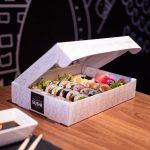In the bustling world of fast food, where speed and convenience reign supreme, there exists an unsung hero that often goes unnoticed—the fast food paper box. This seemingly simple container has quietly revolutionized the way we enjoy our favorite meals on the go. From crispy fries and juicy burgers to savory tacos and sweet desserts, the paper box is the reliable guardian of flavor, freshness, and convenience. Its evolution from a basic wrapper to an engineered masterpiece reflects not only advancements in packaging technology but also a growing commitment to sustainability and consumer experience.
The origins of the fast food paper box can be traced back to the early 20th century, when the rise of automobile culture and busy urban lifestyles created a demand for portable meals. Initially, food was wrapped in paper or served in simple containers, but these often failed to preserve heat, prevent sogginess, or withstand grease. The invention of the paper box, with its sturdy construction and clever design, addressed these issues head-on. Its ability to lock in heat while allowing steam to escape ensured that food remained crispy and delicious, making it an instant hit among both consumers and restaurateurs.
Today, the fast food paper box is a marvel of engineering and design. Made from durable, food-grade paperboard, it is often coated with a thin layer of polyethylene or wax to resist moisture and grease. This ensures that your burger stays dry, your fries remain crisp, and your meal arrives intact, no matter how far you travel. The box’s compact yet spacious design maximizes efficiency for storage and transportation, while its easy-to-open tabs and secure closures make it incredibly user-friendly. Some boxes even feature innovative vents to regulate temperature and prevent condensation, elevating the eating experience to new heights.
Beyond functionality, the fast food paper box plays a crucial role in branding and marketing. With ample space for logos, slogans, and vibrant graphics, it serves as a mobile advertisement for restaurants. The iconic red and yellow of a certain burger chain or the distinctive green of a popular coffee brand are instantly recognizable, turning every meal into a brand experience. This silent ambassador not only reinforces customer loyalty but also attracts new patrons through its visual appeal and association with quality and reliability.
In recent years, sustainability has become a key focus in the packaging industry, and the fast food paper box has risen to the challenge. Many boxes are now made from recycled materials and are fully recyclable or compostable, reducing their environmental footprint. Brands are increasingly adopting eco-friendly practices, such as using soy-based inks for printing and minimizing plastic coatings. This shift not only aligns with growing consumer demand for greener options but also demonstrates the industry’s commitment to protecting our planet for future generations.
Looking ahead, the future of the fast food paper box is bright with innovation. Smart packaging technologies, such as QR codes that provide nutritional information or augmented reality experiences, are being integrated into designs. Biodegradable and plant-based materials are becoming more prevalent, pushing the boundaries of sustainability. As consumer preferences continue to evolve, the paper box will undoubtedly adapt, offering even greater convenience, functionality, and environmental responsibility. It may be humble in appearance, but its impact on our daily lives and the fast food industry is profound and enduring.
In conclusion, the fast food paper box is far more than just a container; it is a testament to human ingenuity and adaptability. It has seamlessly integrated into our fast-paced lives, ensuring that we can enjoy delicious, hot meals wherever we are. So, the next time you unwrap your favorite fast food treat, take a moment to appreciate the clever design and thoughtful engineering of its paper box—a true hero in the world of convenience dining.




Leave a Message